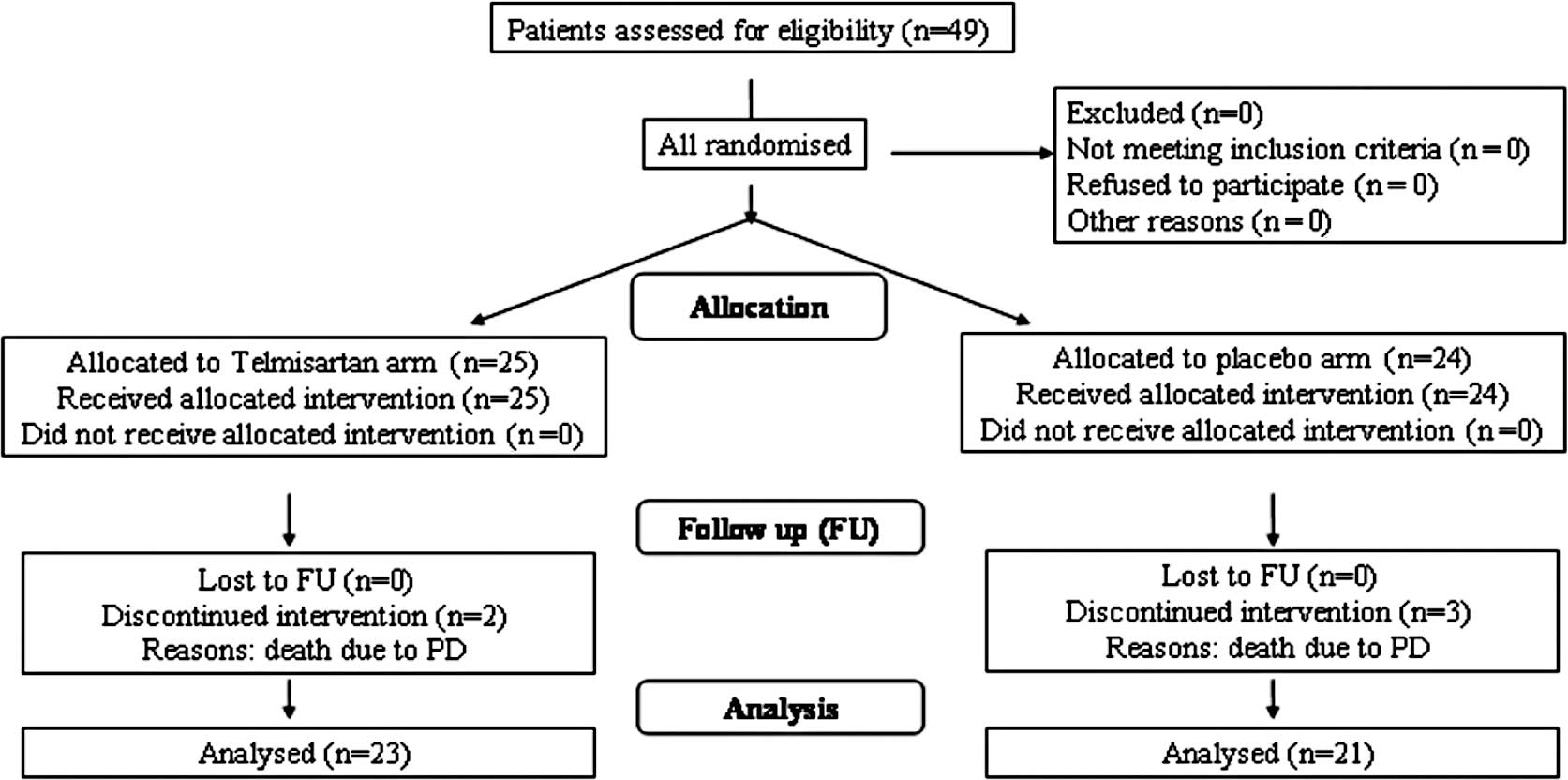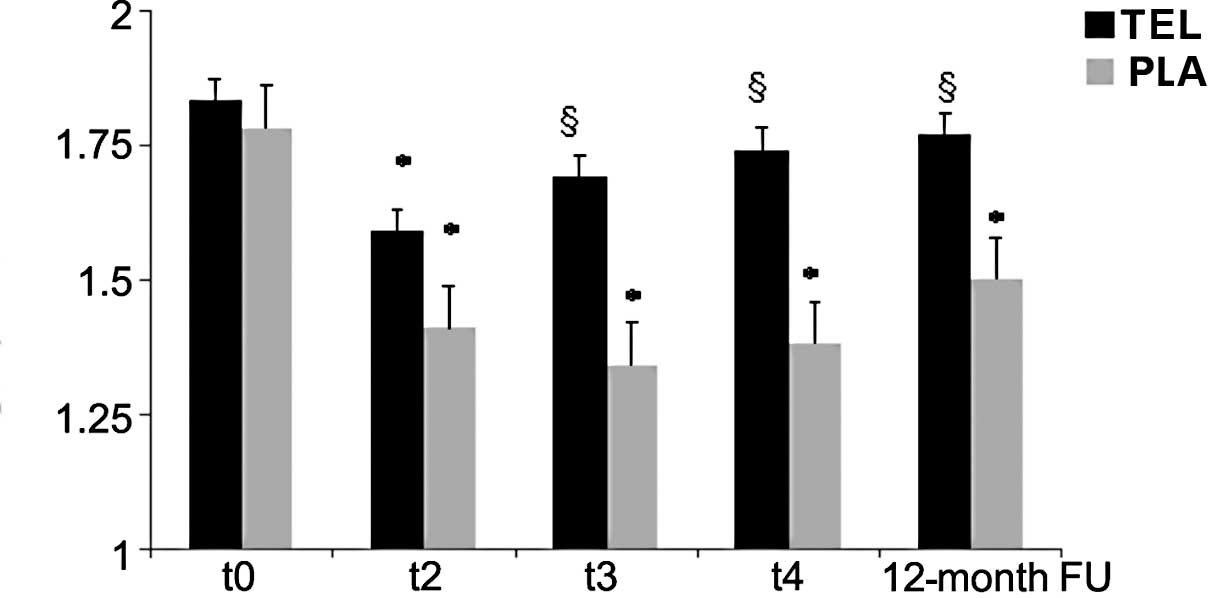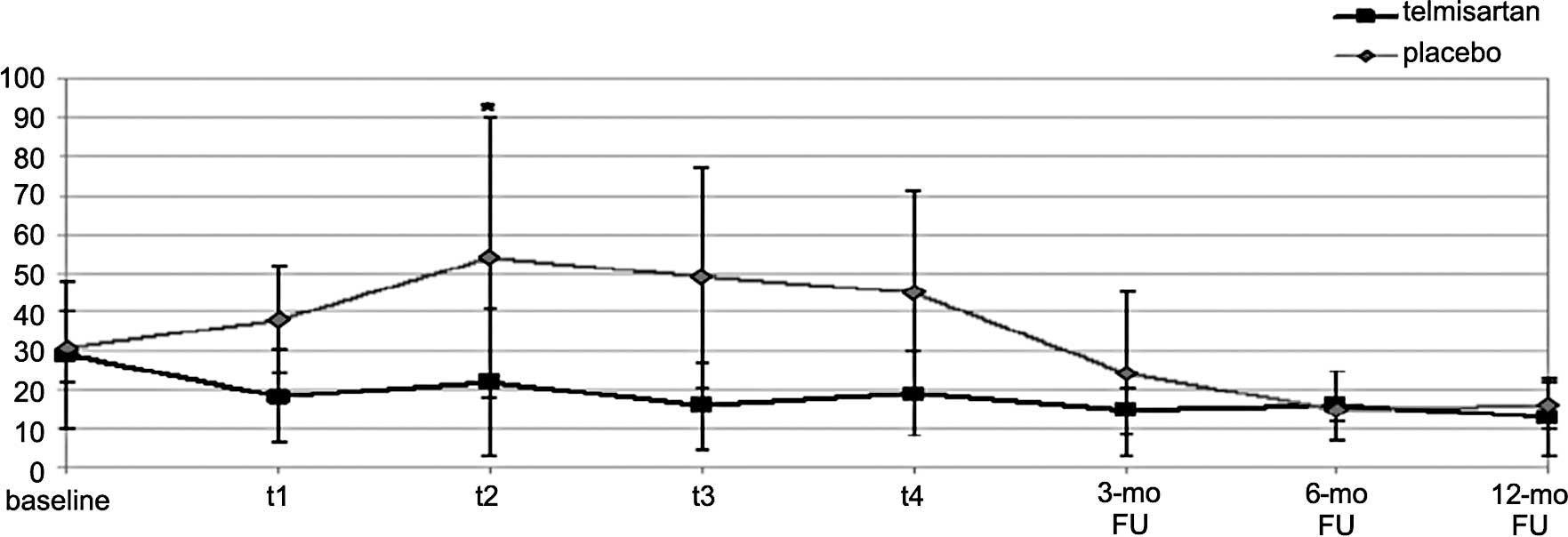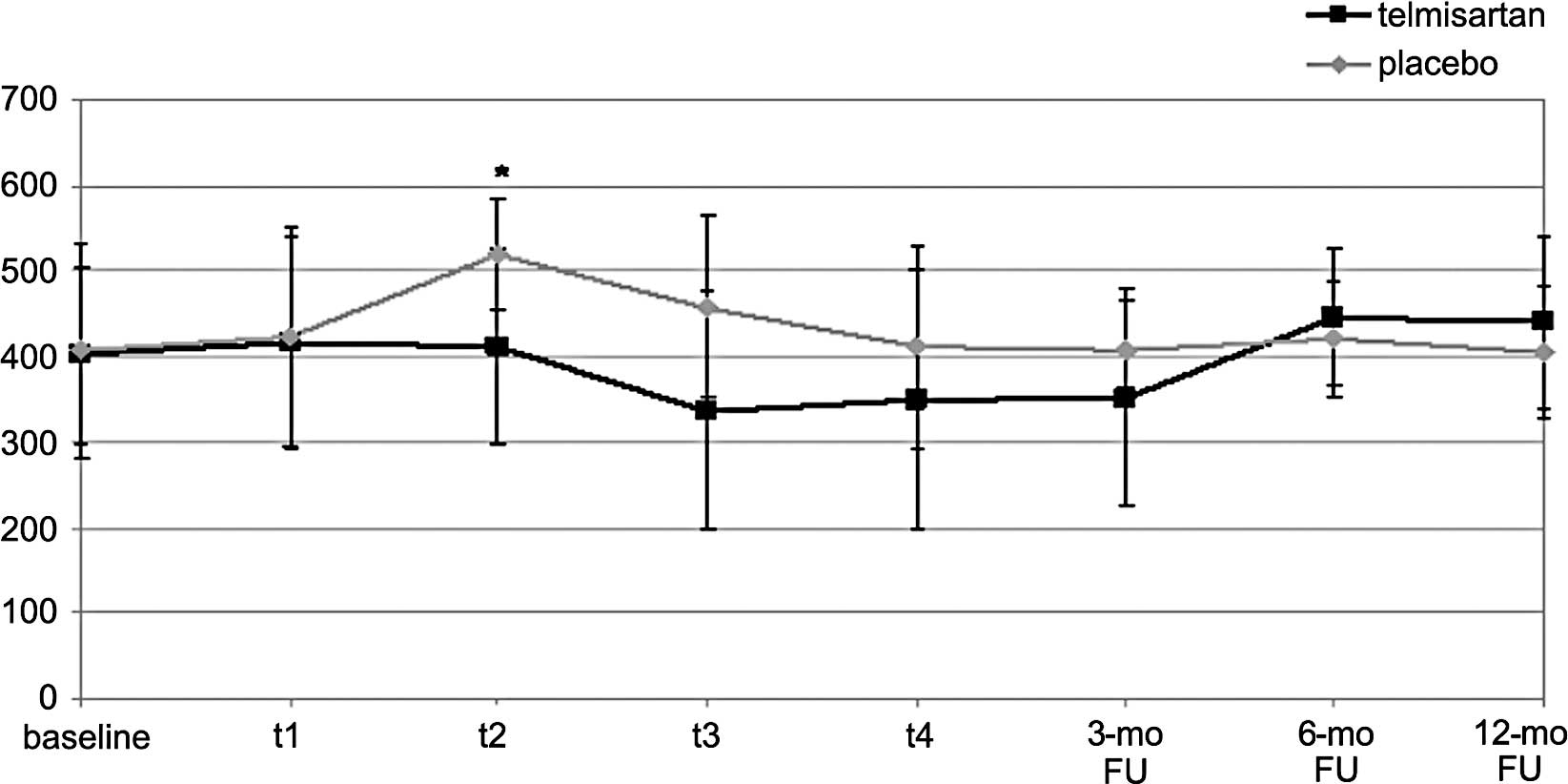|
1.
|
Escobar E, Rodriguez-Reyna TS, Arrieta O
and Sotelo J: Angiotensin II, cell proliferation and angiogenesis
regulator: biologic and therapeutic implications in cancer. Curr
Vasc Pharmacol. 2:385–399. 2004. View Article : Google Scholar : PubMed/NCBI
|
|
2.
|
Thompson KL, Rosenzweig BA, Zhang J, et
al: Early alterations in heart gene expression profiles associated
with doxorubicin cardiotoxicity in rats. Cancer Chemother
Pharmacol. 66:303–314. 2010. View Article : Google Scholar : PubMed/NCBI
|
|
3.
|
Funao K, Matsuyama M, Kawahito Y, et al:
Telmisartan is a potent target for prevention and treatment in
human prostate cancer. Oncol Rep. 20:295–300. 2008.PubMed/NCBI
|
|
4.
|
Paulides M and Wojnowski L:
[Chemotherapeutics-induced heart failure]. Med Klin. 102:574–578.
2007.(In German).
|
|
5.
|
Meldrum DR, Cleveland JC Jr, Cain BS, Meng
X and Harken AH: Increased myocardial tumor necrosis factor-alpha
in a crystalloid-perfused model of cardiac ischemia-reperfusion
injury. Ann Thorac Surg. 65:439–443. 1998. View Article : Google Scholar
|
|
6.
|
Kupatt C, Habazettl H, Goedecke A, et al:
Tumor necrosis factor-alpha contributes to ischemia- and
reperfusion-induced endothelial activation in isolated hearts. Circ
Res. 84:392–400. 1999. View Article : Google Scholar : PubMed/NCBI
|
|
7.
|
Mercuro G, Cadeddu C, Piras A, et al:
Early epirubicin-induced myocardial dysfunction revealed by serial
tissue Doppler echocardiography: correlation with inflammatory and
oxidative stress markers. Oncologist. 12:1124–1133. 2007.
View Article : Google Scholar
|
|
8.
|
Mantovani G, Madeddu C, Cadeddu C, et al:
Persistence, up to 18 months of follow-up, of epirubicin-induced
myocardial dysfunction detected early by serial tissue Doppler
echocardiography: correlation with inflammatory and oxidative
stress markers. Oncologist. 13:1296–1305. 2008. View Article : Google Scholar
|
|
9.
|
Toko H, Oka T, Zou Y, et al: Angiotensin
II type 1a receptor mediates doxorubicin-induced cardiomyopathy.
Hypertens Res. 25:597–603. 2002. View Article : Google Scholar : PubMed/NCBI
|
|
10.
|
Soga M, Kamal FA, Watanabe K, et al:
Effects of angiotensin II receptor blocker (candesartan) in
daunorubicin-induced cardiomyopathic rats. Int J Cardiol.
110:378–385. 2006. View Article : Google Scholar : PubMed/NCBI
|
|
11.
|
Oken MM, Creech RH, Tormey DC, et al:
Toxicity and response criteria of the Eastern Cooperative Oncology
Group. Am J Clin Oncol. 5:649–655. 1982. View Article : Google Scholar : PubMed/NCBI
|
|
12.
|
Iqbal M, Dubey K, Anwer T, Ashish A and
Pillai KK: Protective effects of telmisartan against acute
doxorubicin-induced cardiotoxicity in rats. Pharmacol Rep.
60:382–390. 2008.PubMed/NCBI
|
|
13.
|
Ishiguro H, Ishiguro Y, Kubota Y and
Uemura H: Regulation of prostate cancer cell growth and PSA
expression by angiotensin II receptor blocker with peroxisome
proliferator-activated receptor gamma ligand like action. Prostate.
67:924–932. 2007. View Article : Google Scholar : PubMed/NCBI
|
|
14.
|
Cadeddu C, Piras A, Mantovani G, et al:
Protective effects of the angiotensin II receptor blocker
telmisartan on epirubicin-induced inflammation, oxidative stress,
and early ventricular impairment. Am Heart J. 160:e481–e487. 2010.
View Article : Google Scholar
|
|
15.
|
Wenzel P, Schulz E, Oelze M, et al:
AT1-receptor blockade by telmisartan upregulates GTP-cyclohydrolase
I and protects eNOS in diabetic rats. Free Radic Biol Med.
45:619–626. 2008. View Article : Google Scholar : PubMed/NCBI
|
|
16.
|
Stephen RL, Gustafsson MC, Jarvis M, et
al: Activation of peroxisome proliferator-activated receptor delta
stimulates the proliferation of human breast and prostate cancer
cell lines. Cancer Res. 64:3162–3170. 2004. View Article : Google Scholar
|
|
17.
|
Jensen BV, Skovsgaard T and Nielsen SL:
Functional monitoring of anthracycline cardiotoxicity: a
prospective, blinded, long-term observational study of outcome in
120 patients. Ann Oncol. 13:699–709. 2002. View Article : Google Scholar : PubMed/NCBI
|
|
18.
|
Jalowy A, Schulz R and Heusch G: AT1
receptor blockade in experimental myocardial ischemia/reperfusion.
Basic Res Cardiol. 93(Suppl 2): 85–91. 1998. View Article : Google Scholar
|
|
19.
|
Ferreira AL, Matsubara LS and Matsubara
BB: Anthracycline-induced cardiotoxicity. Cardiovasc Hematol Agents
Med Chem. 6:278–281. 2008. View Article : Google Scholar
|
|
20.
|
Cianchetti S, del Fiorentino A, Colognato
R, di Stefano R, Franzoni F and Pedrinelli R: Anti-inflammatory and
anti-oxidant properties of telmisartan in cultured human umbilical
vein endothelial cells. Atherosclerosis. 198:22–28. 2008.
View Article : Google Scholar : PubMed/NCBI
|
|
21.
|
Yamagishi S and Takeuchi M: Telmisartan is
a promising cardiometabolic sartan due to its unique
PPAR-gamma-inducing property. Med Hypotheses. 64:476–478. 2005.
View Article : Google Scholar : PubMed/NCBI
|
|
22.
|
Tuck ML: Angiotensin-receptor blocking
agents and the peroxisome proliferator-activated receptor-gamma
system. Curr Hypertens Rep. 7:240–243. 2005. View Article : Google Scholar : PubMed/NCBI
|
|
23.
|
Minotti G, Menna P, Salvatorelli E, Cairo
G and Gianni L: Anthracyclines: molecular advances and
pharmacologic developments in antitumor activity and
cardiotoxicity. Pharmacol Rev. 56:185–229. 2004. View Article : Google Scholar : PubMed/NCBI
|
|
24.
|
Conklin KA: Coenzyme q10 for prevention of
anthracycline-induced cardiotoxicity. Integr Cancer Ther.
4:110–130. 2005. View Article : Google Scholar : PubMed/NCBI
|
|
25.
|
Kaur K, Sharma AK, Dhingra S and Singal
PK: Interplay of TNF-alpha and IL-10 in regulating oxidative stress
in isolated adult cardiac myocytes. J Mol Cell Cardiol.
41:1023–1030. 2006. View Article : Google Scholar : PubMed/NCBI
|
|
26.
|
Sipahi I, Debanne SM, Rowland DY, Simon DI
and Fang JC: Angiotensin-receptor blockade and risk of cancer:
meta-analysis of randomised controlled trials. Lancet Oncol.
11:627–636. 2010. View Article : Google Scholar : PubMed/NCBI
|


















